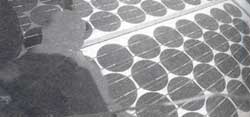Green rules
 IF GREEN plants can capture 95 per cent of the total energy from sunlight through the process of photosynthesis, why can't the solar photo-voltaic cells (SPV)? The best SPVS are able to absorb only 25 per cent of the solar energy available on the surface of the Earth -- a fact that has puzzled solar energy advocates for quite sometime.
IF GREEN plants can capture 95 per cent of the total energy from sunlight through the process of photosynthesis, why can't the solar photo-voltaic cells (SPV)? The best SPVS are able to absorb only 25 per cent of the solar energy available on the surface of the Earth -- a fact that has puzzled solar energy advocates for quite sometime.
A team of British researchers have identified the details of the atomic structure of the "light harvesting system" -- the place in the leaf where energy from sunlight is absorbed in a strain of purple bacteria. The findings could help in designing more effective spv cells.
Green plants and photosyntheic bacteria employ an extremely sensitive and effective molecular-antennae system that absorbs individual photons and quickly passes on the energy to the "reaction centre" -- the place where photosynthesis proper, or the splitting of water molecules begin.
The research team from the University of Glasgow and Daresbury Laboratory, Cheshire, used 3-dimensional x-ray crystallography -- a technique used for studying the structure of the "reaction centre". They observed two concentric cylinders, a couple of millionth of a millimetre across, of a spiralling protein molecule, enclosing a ring of chlorophyll (a chemical pigment that initially absorbs sunlight). When a photon excites 1 of the chlorophyll molecules, the energy is transferred quickly around the ring to a point near the reaction centre.
Now that 1 biochemical structure that efficiently captures solar energy is available as a guide, it can become an ingredient in a more efficient future solar cell, they argue.
Related Content
- Judgment of the Supreme Court regarding district survey report for environmental clearance, 08/05/2025
- Order of the Supreme Court regarding construction of houses in forest area, Madhya Pradesh, 29/04/2025
- Response by applicant, Raja Muzaffar Bhat to report of Jammu & Kashmir Pollution Control Committee on the illegal disposal of waste on the banks of river Poonch, 16/04/2025
- Report filed by the Central Pollution Control Board on waste to energy plants, 15/04/2025
- Affidavit filed by the Central Pollution Control Board regarding implementation of Biomedical Waste Management Rules, 2016, 15/04/2025
- Order of the National Green Tribunal regarding forest encroachment in the process of construction of aerial ropeway connecting the base of Savitri Mandir hill to its summit in Pushkar, Rajasthan, 09/04/2025
